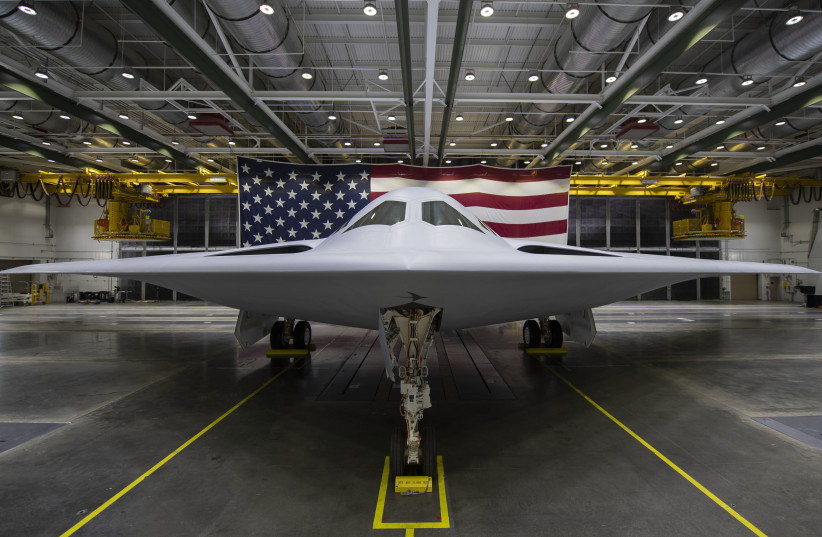The unveiling of the B-21 Raider, a new American hi-tech nuclear stealth bomber and the docking of the nuclear-powered USS West Virginia submarine in the Indian Ocean are both two large symbols of US power in an age of regional rivalries.
US President Joe Biden had vowed to show that “America is back” on the world stage after the Trump administration flirted with more isolationist foreign policies. Do a new stealth bomber and the release of details about the movement of a nuclear submarine showcase the American global footprint?
The details about the plane and the submarine are intended to send a message. The US didn’t need to reveal information on either of these developments. Instead, it said: “for the first time, a US Navy nuclear-powered ballistic missile submarine docked at the remote island of Diego Garcia in the Indian Ocean as part of an extended months-long deployment,” according to CNN. The ship was in port from October 25-31. “The specific movements of Navy submarines are highly classified while they are sea, so the delayed announcement would have given the submarine the time to transit to other locations in the Indian Ocean,” CNN reported.
The US then revealed that it has a new nuclear stealth bomber.
The B-21 Raider
The B-21 Raider is a long-range bomber that can carry different types of weapons. It is apparently the first new US bomber in 30 years. Back in the 1990s, the US introduced the B-2 stealth bomber. Only 21 of those were built.

According to reports, there are already six of the new B-21s. The new plane has an “open architecture” meaning that more new systems can be integrated into it in the future. Clearly, the intention here is to create a platform that can dominate for decades to come.
Reports have said that it can be flown without a crew and can work in both manned and unmanned teaming formats. This means that the US is looking towards a future of drone warfare where planes may fly alongside drones, or that the planes may be unmanned.
The B-21 is expensive, capping at some $700 million. It is made by Northrop Grumman, the group the B-2. Both are in a “flying wing” format, and they have low observable or stealth technology. It is worth recalling that Northrop and McDonnell Douglas were behind the YF-23, the sophisticated plane that lost out to the Lockheed Martin F-22 Raptor. Lockheed also makes the F-35. Lockheed also makes the RQ-170 Sentinel, a flying wing style surveillance drone.
The US is flexing its muscles
Overall, the US is not only showing off new technology and flexing its muscles by showing off where one of its premier submarines is, the US Navy also interdicted another attempt by Iran to move weapons and fuel for weapons to the Houthis in Yemen.
The US Navy said on Saturday that it found one million rounds of ammunition and rocket fuses on a ship disguised as a fishing trawler headed to Yemen. The US Navy also found 70 tons of missile fuel on a stateless dhow plying the smuggling route from Iran to Yemen in mid-November.
The US Navy in the region, which is headquartered in Bahrain and operates under the umbrella of 5th Fleet as part of US Central Command’s NAVCENT component, is also conducting drills with unmanned systems. This event is called Digital Horizon and the US Navy says it is the “command’s efforts to integrate new unmanned technologies while establishing the world’s first unmanned surface vessel fleet by end of next summer. US 5th Fleet’s efforts are focused on improving what US and regional navies are able to see above, on and below the water.”
The US Navy is focused on bringing in new technology to help out in the region. Task Force 59 is part of this effort and Digital Horizon has brought together 17 industry partners “bringing 15 different types of systems, 10 of which will operate with US 5th Fleet for the first time,” according to a US Navy report.
Why this matters is that, like the B-21, the new systems have unmanned elements. This will mean the future of US operations will include a lot of drones and these types of hi-tech systems.
US naval power is directly linked to US global power. This has been the case for more than a century. Today, the common belief is that US national defense strategy must confront “near-peer” rivals, such as China and Russia. This comes after America invested heavily in the global war on terror from 2001-2020. That meant investment in special forces and large drones that can’t survive in contested airspace; meaning they can’t survive modern air defenses.
Now the US is concentrating on being “back,” meaning that it has to keep up with the kinds of drones, warplanes and ships that China is rolling out. China appears to be building warships at a frenetic pace. That means the US Navy has to also do a show of force and conduct the kind of missions that the US did in the last century to show that freedom of navigation matters and that countries such as South Korea, Japan or the Philippines will not be bullied; and that Taiwan will be protected.
The origins of this US policy are clear. A bit less than a century and a half ago, US naval officer Alfred Thayer Mahan was working on his book The Influence of Sea Power Upon History, 1660–1783 (1890), a seminal work that helps inform US blue water strategy to this day. Soon after British Admiral Jackie Fisher led efforts to modernize the British navy, introducing oil fueling and steel-hulled battle cruisers, laying the base for modern navies. As we look forward to the coming decades and the US attempt to commit itself to global security, the ability of the US to use ships, unmanned systems and new warplanes will be key.
